Nvidia GeForce GTX 460 1GB Fermi Review
Nvidia GeForce GTX 460 1GB Fermi
Nvidia's new mid-range graphics card is the one to get.
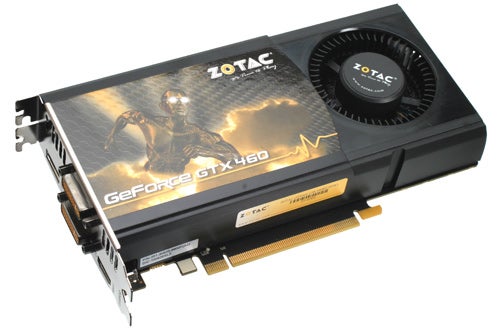
Verdict
Key Specifications
- Review Price: £200.00
 (centre)
(centre)
Best PC Component(/centre)
The GTX 460 is the latest addition to Nvidia’s DirectX 11 compatible range of graphics cards. Aimed squarely at the mid-range of the market, it should be a great buy for those looking for a decent amount of bang for their buck. Let’s find out is it lives up to expectations.
Nvidia’s first set of DirectX 11 graphics cards didn’t exactly set the world alight. They were all based on a new architecture called Fermi and used a new chip based on that design, the GF100, that on paper looked very impressive. Unfortunately for Nvidia it didn’t quite live up to its billing. Heat, power consumption, and primarily manufacturing problems plagued the GTX 480 and GTX 470 and neither delivered the performance to justify these compromises. What’s more, Nvidia charged extortionate prices for them (£450+) when they first came out – it really wasn’t a good episode for the company. 
A few months later it released the GTX 465, which used a heavily cut down (i.e. bits disabled) version of GF100 that was meant as a stop gap to tackle the mid-range market. However, it also failed to deliver on all fronts.
Now Nvidia has finally released a card based on a brand new chip, designed from the ground up to be smaller and less powerful but that should deliver in terms of all the other aspects of a graphics card; heat, power consumption, noise, and pricing. That card is the GTX 460 and the chip it’s based on is dubbed the GF104.
We won’t cover the detailed inner workings of the Fermi architecture in this review (for that we refer you to our review of the GTX 470) but we will give you a brief overview of the differences between GF100 and GF104. 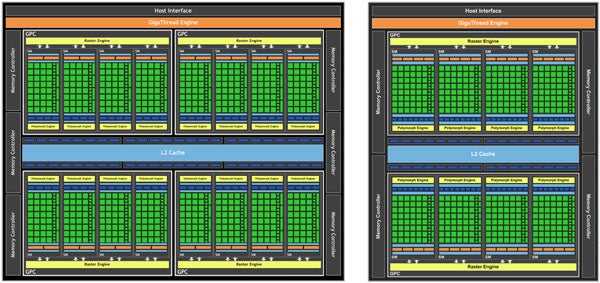
GF100 contains 512 Stream Processors (SP), or Cuda cores as Nvidia likes to call them, which are the main processing units of the chip. These are split up into sets of 32, in what’s called a Streaming Multiprocessor (SM). This also adds four texture units, some cache, thread schedulers, and the polymorph engine, which handles geometry processes like tesselation.
Four of these SMs are then clustered together to form a General Processing Cluster (GPC), which basically just adds a raster engine (the bit that converts 3D models into 2D pixels). Finally, four of these GPCs are added together along with further thread scheduling components, the host interface, memory controllers, ROPs (48 of them split into six sections), and 512KB of L2 cache. The result is one enormous and hot chip that contains a whopping 3.1bn transistors. However, due to production problems, the GTX 480, has one of the SMs disabled so you actually get 480 SPs, 15 SMs, and 60 texture units. 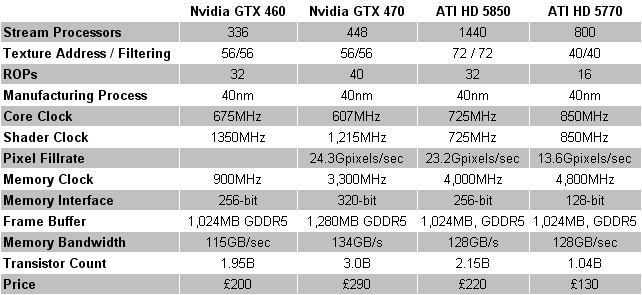
For GF104, all the basic building blocks are very similar, but their proportions have been tweaked. So, you get 384 SPs, split up between just eight SMs, giving you 48 SPs per SM. To deal with these extra SPs, each SM also has double the number of texture units. Each SP has also had a second dispatch port added for more efficient thread handling. Finishing things off, GF104 has 32 ROPs, split up into four sections. The result is that despite at first glance looking like it is only half the chip that GF100 was, GF104 is considerably more than this – something that’s reflected in its transistor count of 1.95bn.
So we come to the cards that will actually be using the GF104 chip. Like the GTX 480, the new cards won’t actually use the full potential of the chips they’re based on. Instead, one of the SMs has been disabled. This is because the art of manufacturing these chips is a fine one and even the slightest defect can render a chip useless. As such, if Nvidia promised a full working chip, it would have problems producing them in enough numbers. By disabling the section of the chip that is defective, many more can still be used. This isn’t a problem unique to Nvidia, but it is obviously still suffering more from it than AMD/ATI as that company hasn’t had to resort to such measures. 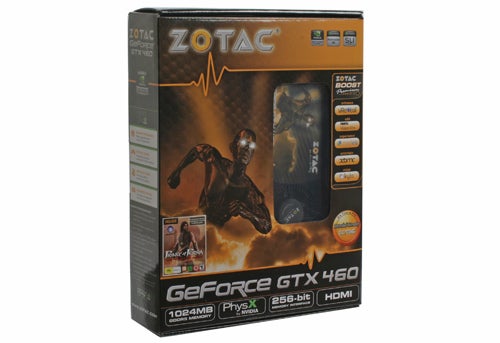
There will also be two versions of the GTX 460, one with 1GB of RAM and one with 768MB. The latter also has a reduced memory sub-system with the amount of L2 cache dropping from 512KB to 384KB and the number of ROPs from 32 to 24. We shall be taking a look at this version of the card shortly.
Today, then, we’re looking at the Zotac GeForce GTX 460 1GB, which uses a reference design and runs at standard clock speeds, unlike some cards on the market that come pre-overclocked. Nvidia hasn’t stipulated a stock cooler for the GTX 460 and has instead left it up to board partners to choose their own setups. As such there are a number of different variations on offer. 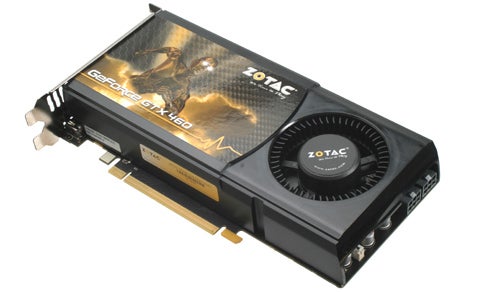
The card we’re looking at uses a radial fan sucking air in from the front of the card, blowing it across the heatsink and out the back of the card. Others use axial fans blowing straight down onto the card. Generally we prefer the approach Zotac has taken as these coolers exhaust the hot air straight out of your PC case. However, this particular design isn’t the quietest we’ve encountered with it idling at 48dB (measured from 30cm away) and rising to 53dB under load.
In contrast the stock (i.e. Nvidia designed) cooler on the GTX 470 runs at 40dB/50dB, while ATI’s competing cards also run at sub 40dB when idling. The Zotac card isn’t loud enough to disturb you if you’re just sitting working with some music on, say, but if you have your PC in your bedroom, it may be enough to keep you awake at night. 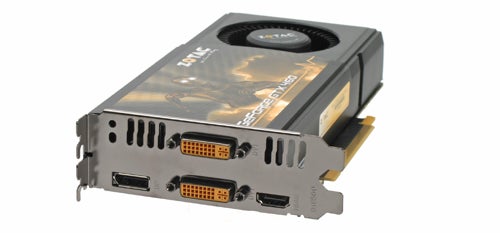
Otherwise, the Zotac design seems fine. It’s 218mm long, which is plenty short enough to fit in most cases, and you get oodles of video outputs, with two DVI, an HDMI and a DisplayPort on offer – more than any other card we’ve seen from Nvidia.
One thing we didn’t expect to see on a card that looks fairly small and unassuming is two six-pin PCI-E power connectors. The official TDP of the GTX 460 1GB is 160W, so it just creeps over the safe limit of using just one connector – it’ll be interesting to see how much headroom this leaves for overclocking. Another interesting thing to note is the presence of only one SLI connector along the top edge, which means you can ”only” run two of these together and not three. 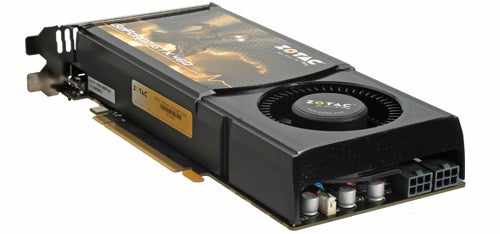
In the box, along with the card, Zotac also bundles a copy of Prince of Persia: The Forgotten Sands, two twin-Molex to six-pin PCi-E connectors and a DVI to VGA adapter. Zotac also offers a competitive 5 year warranty on its cards. All told, we think it’s quite a compelling package. All that’s left to do know is see how the thing performs.
We have compared the GTX 460 1GB to the ATI Radeon HD 5850, ATI Radeon HD 5830, and the GTX 470, which are all priced around the same £200 mark. We use the same test bed that consists of an Asus P6T motherboard equipped with an Intel Core i7 965, 6GB Kingston DDR3 RAM, and a 2TB Seagate Barracuda XT hard drive.
Apart from Crysis, we run each game at its highest detail level and do manual run throughs recording frames per second using FRAPs. For Crysis we run a custom time demo and use the widely available Crysis benchmarking tool. We also run it at ”only” High detail settings, not Very High.

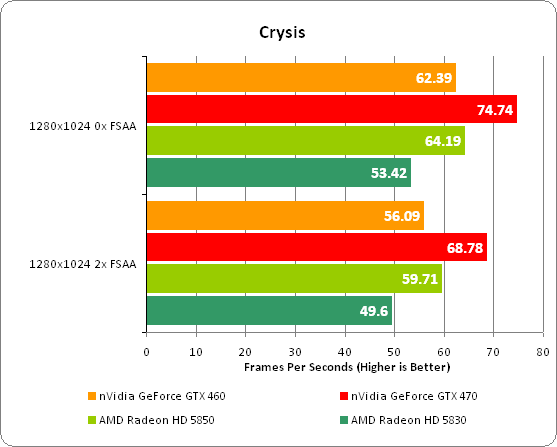
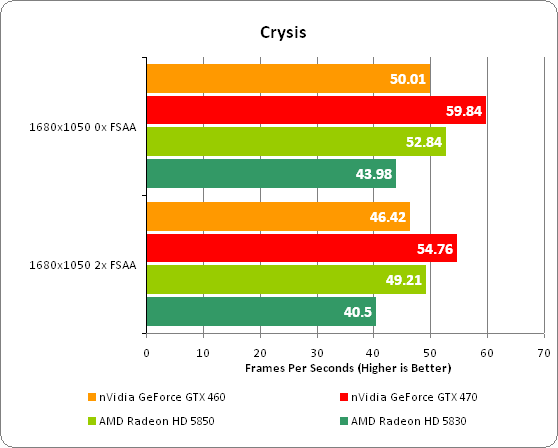
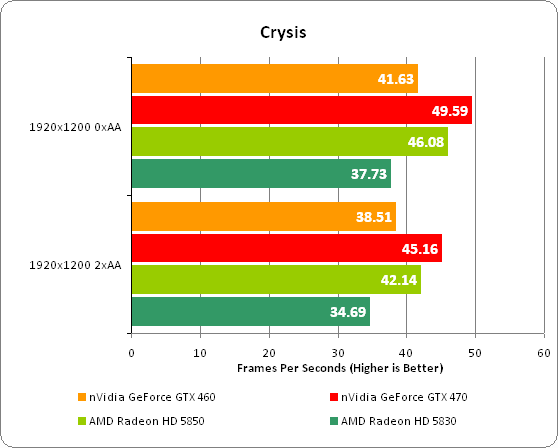
—-
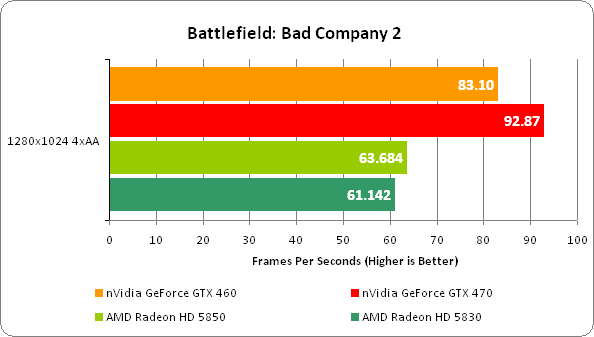
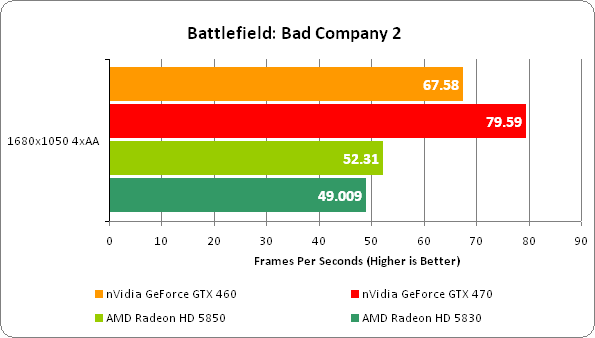
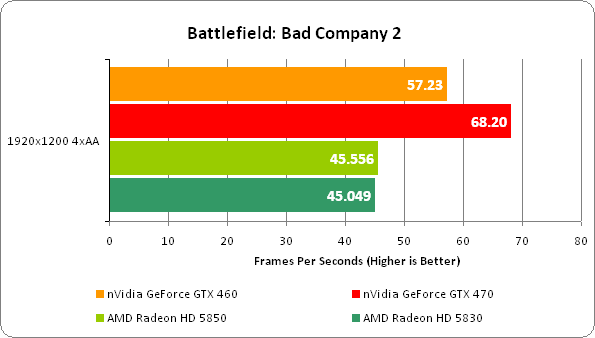
—-
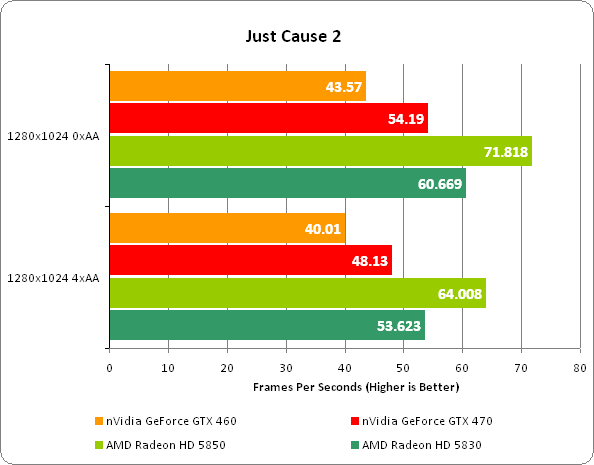
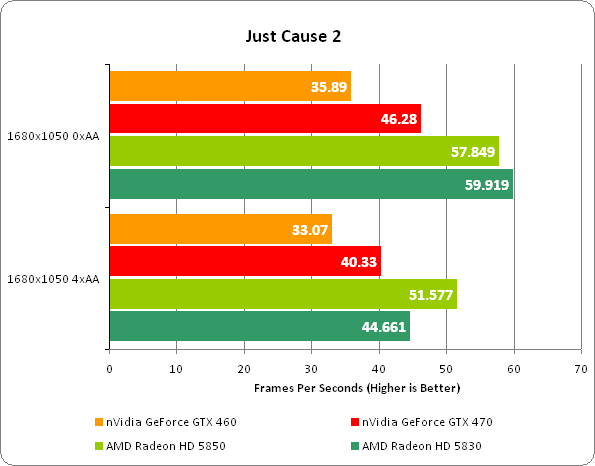
—-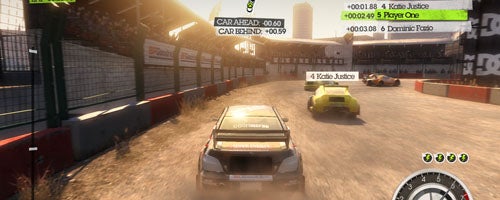
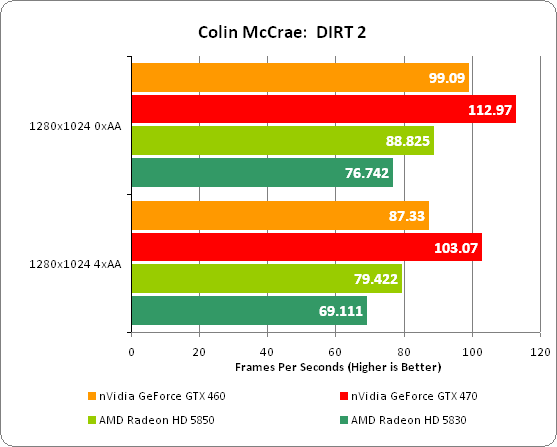
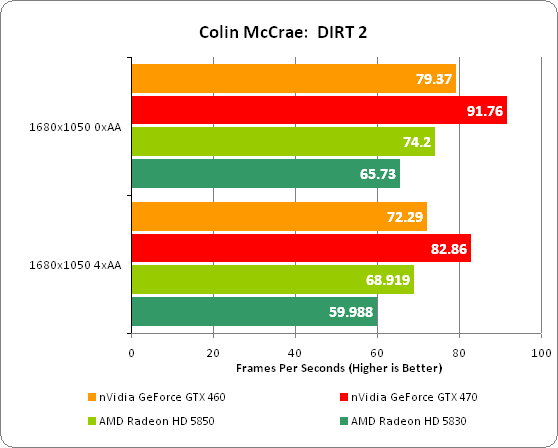
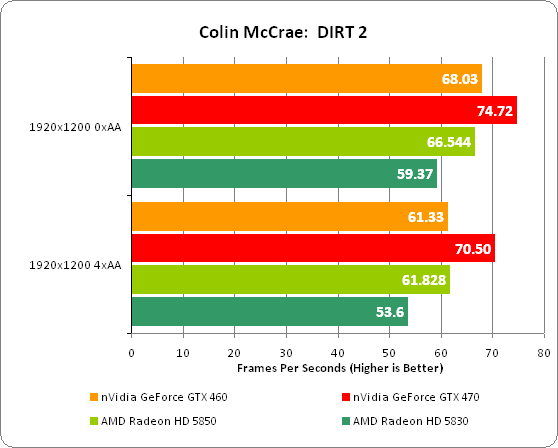
For analysis of these results, navigate to the Analysis and Verdict page.
We record power consumption using a mains power meter, as such the results shown reflect the total system power. The idle figure shows the power consumption when the system is doing nothing except showing the Windows desktop while the under load figure is taken while performing a run through of our Crysis timedemo with settings of 1,920 x 1,200 with 2xAA. 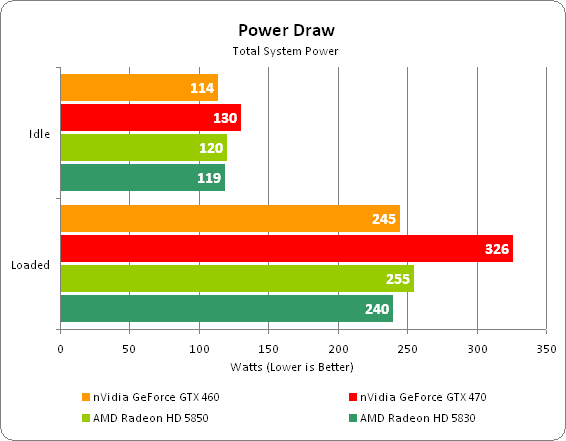
Noise readings are taken with the entire system (except the power supply, and disk drives) enclosed in a sound reducing box. A decibel meter is then held 30 centimetres away from the card while all other components are passively cooled. Again, we measure when at the desktop and when running Crysis. 
For analysis of these results, navigate to the Analysis and Verdict page.
We started out testing with that perennial graphics card torturer, Crysis. Here the GTX 460 1GB puts in an impressive performance, easily providing playable framerates at 1,920 x 1,200 with 2xAA. It also comfortably beats its most direct rival, the HD 5830 and giving the more expensive HD 5850 and GTX 470 a run their money. 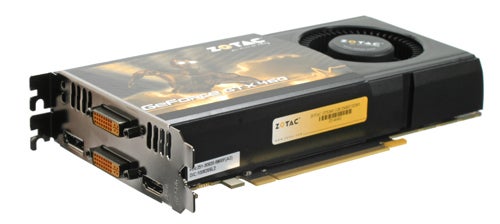
Moving onto a more modern title, Battlefield: Bad Company 2, and the GTX 460 looks even more impressive, opening up a comfortable lead over competing cards from ATI and maintaining playable framerates again at 1,920 x 1,200 with 4xAA. At a push you could probably even play at 30in monitor resolutions of 2,560 x 1,600.
It’s a complete role reversal when it comes to Just Cause 2. This title clearly favours ATI’s cards and the GTX 460 1GB loses out badly, struggling even to maintain playable framrates at 1,680 x 1,050.
Finishing up with Colin McCrae: DIRT 2, all cards on test could comfortably play at 1,920 x 1,200 with 4xAA, and you could again probably stretch to 2,560 x 1,600. There’s not much in it between the cards either, but the GTX 460 does consistently stay ahead of ATI’s competing cards.
As for noise and power consumption, we’ve already mentioned this particular Zotac card isn’t the quietest but it’s still within the realms of acceptability. It also does well when it comes to power consumption, keeping toe to toe with ATI’s competing cards. Most notably, it’ clear the tweaks made to the GF104 chip have paid dividends as it consumes vastly less power than the GF100 powered GTX 470. 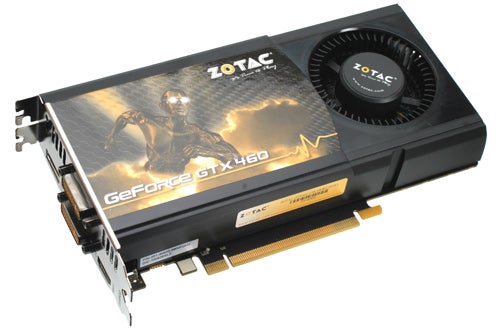
All told, then, the GTX 460 1GB is an impressive beast. On average throughout our tests, it performed better than ATI’s competing cards at this price range, it’s not too noisy and power consumption is as competitive as anything else. Once you factor in Nvidia’s exclusive extras like PhysX and 3D gaming, you have a clear winner in this sector.
”’Verdict”’
After the disaster that was the GTX 480 and GTX 470 launch, you’d be forgiven for thinking Nvidia was going to be left high and dry for this 1st round of DirectX 11 graphics cards. However, the company has gone away, done its homework, and comeback with a seriously compelling mid-range graphics card in the shape of the GTX 460. It’s still a fair chunk of money at around £200 but for that money, it’s the best choice out there.
Trusted Score
Score in detail
-
Value 9
-
Features 8
-
Performance 8

